Date March 628 AD | ||
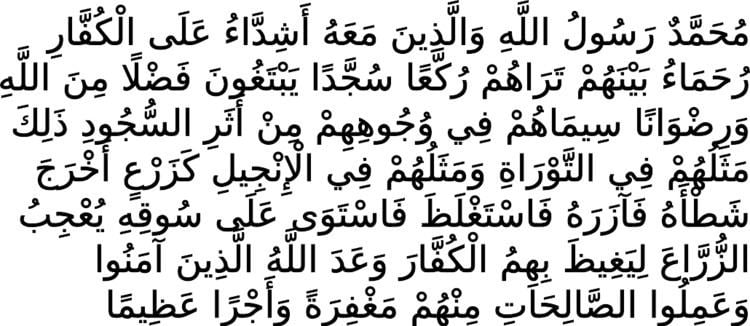 | ||
Treaty of hudaybiyyah
The Treaty of Hudaybiyyah (Arabic: صلح الحديبية) was an important event that took place during the formation of Islam. It was a pivotal treaty between Muhammad, representing the state of Medina, and the Quraysh tribe of Mecca in March 628 (corresponding to Dhu al-Qi'dah, 6 AH). It helped to decrease tension between the two cities, affirmed a 10-year peace, and authorized Muhammad's followers to return the following year in a peaceful pilgrimage. The First Pilgrimage.
Contents
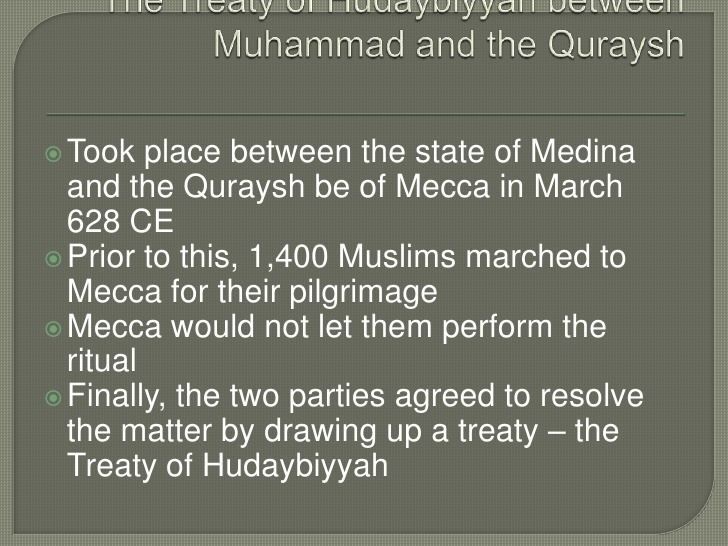
Attempted pilgrimage
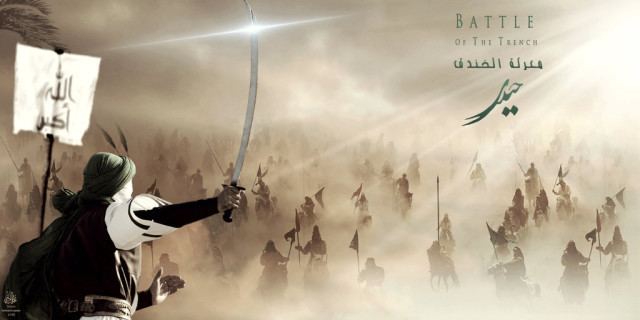
Muhammad had a premonition that he entered Mecca and did tawaf around the Ka'bah. His Companions in Madinah were delighted when he told them about it. They all revered Mecca and the Ka'bah and they yearned to do tawaf there. In 628, Muhammad and a group of 1,400 Muslims marched peacefully without arms towards Mecca, in an attempt to perform the Umrah (pilgrimage). They were dressed as pilgrims, and brought sacrificial animals, hoping that the Quraish would honor the Arabian custom of allowing pilgrims to enter the city. The Muslims had left Medina in a state of ihram, a premeditated spiritual and physical state which restricted their freedom of action and prohibited fighting. This, along with the paucity of arms carried, indicated that the pilgrimage was always intended to be peaceful.
Muhammad and his followers camped outside of Mecca, and Muhammad met with Meccan emissaries who wished to prevent the pilgrims' entry into Mecca. After negotiations the two parties decided to resolve the matter through diplomacy rather than warfare, and a treaty was drawn up.
Treaty
The statement of the treaty was as follows:
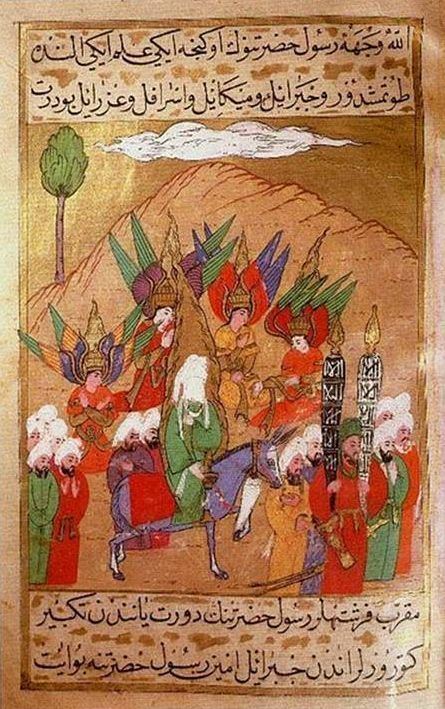
“In your name, O God!
This is the treaty of peace between Muhammad Ibn Abdullah and Suhayl ibn Amr. They have agreed to allow their arms to rest for ten years. During this time each party shall be secure, and neither shall injure the other; no secret damage shall be inflicted, but honesty and honour shall prevail between them. Whoever in Arabia wishes to enter into a treaty or covenant with Muhammad can do so, and whoever wishes to enter into a treaty or covenant with the Quraysh can do so. And if a Qurayshite comes without the permission of his guardian to Muhammad, he shall be delivered up to the Quraysh; but if, on the other hand, one of Muhammad's people comes to the Quraysh, he shall not be delivered up to Muhammad. This year, Muhammad, with his companions, must withdraw from Mecca, but next year, he may come to Mecca and remain for three days, yet without their weapons except those of a traveler, the swords remaining in their sheaths.”
Controversy
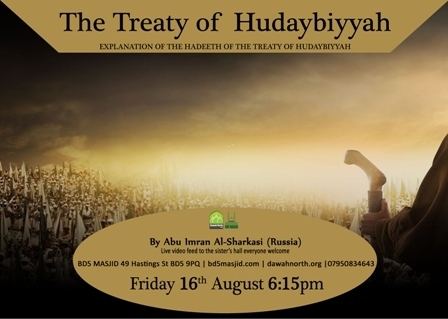
The treaty was quite controversial for many reasons. Originally, the treaty referred to Muhammad as the Messenger of God, but this was unacceptable to the Quraish ambassador Suhayl ibn Amr. Muhammad compromised, and told his cousin Ali to strike out the wording. But Ali said, "I will not be the person to rub it out", after which Muhammad himself rubbed out the words. (Sahih al-Bukhari, 3:49:862, Sahih Muslim, 19:4404).
Another point of contention, was that the Muslims objected over a clause of the treaty that said that any citizen from Mecca entering Medina was eligible to be returned to Mecca (if they wanted), while the reverse was not true, and any Muslim from Medina entering Mecca was not eligible to be returned to the Muslims, even if Muhammad himself requested. (Sahih al-Bukhari, 3:50:874)
A condition was also placed that the Muslims could not enter for their pilgrimage at that time, but could return the following year. The treaty also assured a 10-year peace.
After the signing of the treaty, there was still great resentment and fury among the Muslims because they did not like its stipulations. Muhammad, binding onto the Islamic ethic "fulfill every promise" ordered that Muslims do exactly as the treaty says. Also, many Muslims thereafter objected, when Muhammad told them (thrice) to perform their rites there and then. (Sahih al-Bukhari, 3:50:891)
Muhammad insisted that Muslims had been victorious and was supported in this by new revelation: "Verily we have granted thee a manifest victory" (Qur'an 48:1). He promised much spoils in the near future: "...and He sent down peace of reassurance on them, and hath rewarded them with a near victory, and much booty that they will capture". (Qur'an 48:18-19)
The treaty's stipulations on the movement of persons gave rise to later controversy, when the Quraysh woman Umm Kulthum went to Medina and joined the Muslims, and her brothers demanded her return from Muhammad, as they interpreted the treaty to mean. Muslim commentator Abdullah Yusuf Ali considers that the treaty had already been violated, probably by an attack by the Quraysh-allied tribe of Banu Bakr upon the Muslim tribe of Banu Khuza'a. Thus he believed that divine instruction was needed on what was to be done with migrants from Mecca. Other Muslim sources state that the treaty's restrictions only applied to free men, and not to slaves or women. Ultimately, Muhammad refused on the basis of revelation from God: "When there come to you believing women refugees, examine and test them... if ye ascertain they are believers, send them not to the unbelievers" (Qur'an 60:10). If the woman married a Muslim, the Muslims would pay the Meccan refugee's ex-husband a sum equal to the dower he had paid upon marriage to her". (Qur'an 60:10)
